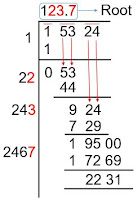SQUARE ROOT
Square root of perfect squares are integers while square root of non perfect squares or positive integers are irrational numbers. For example: Square root of '4' is '2' while root of '3' is 1.73205080..... up-to million digits.
Square Root of Perfect Squares
- Check the unit digit of the given number and write those numbers whose squares give the same unit digit.
- Now neglect last two digits of the given number and find the number whose square is nearest to the given number but not greater.
Here unit digit is 4, those numbers whose squares give the same unit digit are: 2 & 8.
After omitting last two digits which are “24”, only “3” remains, now write those numbers whose square is nearest to 3, but not greater, and that is “1”.
So answer could be ’12’ or ’18’.
To find the correct one, check the middle term of '12' & '18' containing '5' at units place which is ’15’.
Square of 15 is ‘225’ and number ‘324’ is greater than ‘225’, it means correct answer is 18. Square root of 324 is 18.
Square Root of Non-Perfect Squares
Formula: √x = z + (x - y)/2zHere x = given number
y = nearest perfect square
z = Square root of nearest (smaller) perfect square
Example: Find the square root of 160?
Solution: x = 160
Nearest perfect square y = 144
Therefore, z = √144 = 12
⇒ √160 = 12 + (160 - 144)/(2x12)
= 12
Step 2: Divide the number by 'x'
⇒ 6/2 = 3
Step 3: Take the average of 'x' and this quotient.
⇒ (2 + 3)/2 = 2.5 approx.
For better accuracy you can repeat these steps again with 2.5 as new approx value of square root of 'n'.
Square Root of any Number (Basic method)
Step 2: Now multiply a number by itself such that product always less than or equal to the given pair. Here 1x1 =1 which is equal to 1.
Step 3: Now multiply quotient with 2 and bring down the next pair which is '53'.
















No comments:
Post a Comment